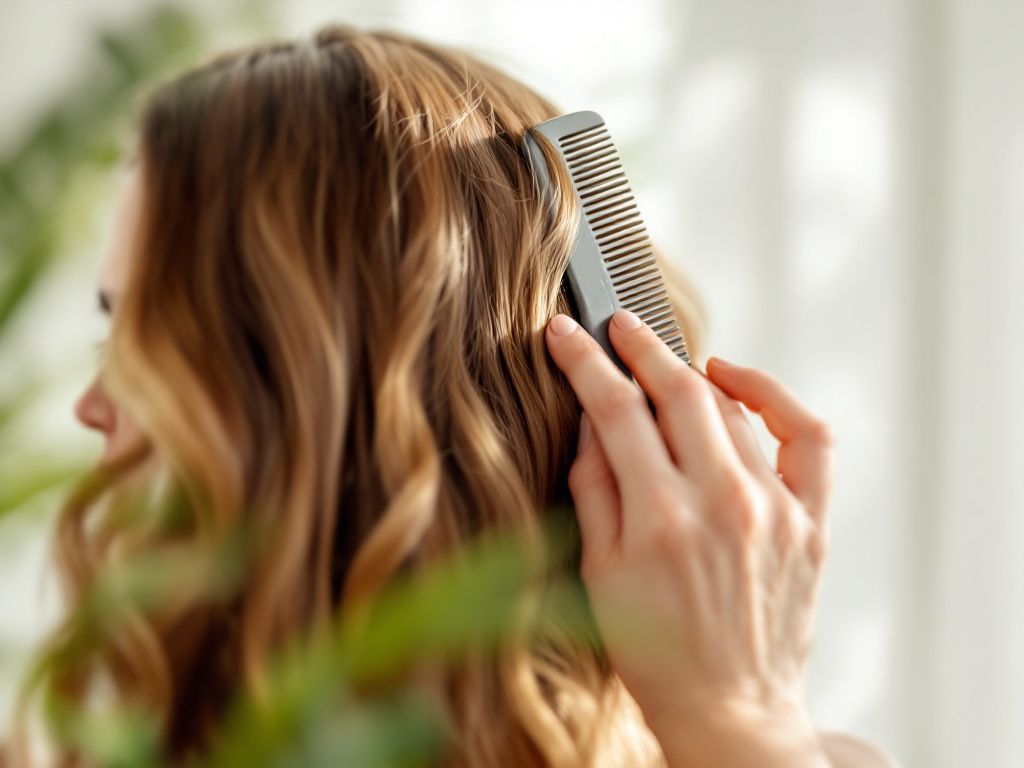
Hey there! You ever find yourself wishing your hair would grow a bit faster or healthier? Yeah, me too. Now, I know, I know—growing hair takes patience. But, believe it or not, something as simple as choosing the right comb can make a difference. Intrigued? Let’s dive into this together and explore how the best comb for hair growth can influence your hair’s health.
Before we get into the whole comb discussion, it’s essential to understand how hair growth actually works. Our hair grows from a little place called the follicle, nestled in our scalp. Like a plant needing the right soil, light, and water, our hair needs a healthy environment to thrive. This is why a minimalist hair care products approach can sometimes be more beneficial than overwhelming your scalp with too many ingredients.
Here’s a quick lowdown: hair grows in cycles. You’ve got the anagen phase (that’s when it’s actively growing), then the catagen phase (a brief transition period), and finally, the telogen phase (resting stage before the hair finally sheds). Applying this knowledge, gentle stimulation of the scalp during the anagen phase can actually promote growth. Enter—the comb. For those who style frequently, understanding hair gel application best practices can also help maintain scalp health and prevent damage that hinders growth.
Ever experienced that pulling or snagging feeling while combing? Not just unpleasant, it can also damage both your hair and scalp. Hair experts swear by this: using the right comb can help prevent breakage and stimulate the scalp, leading to better hair growth conditions. For those dealing with stress-related hair issues, integrating a stress hair loss recovery ritual alongside proper comb use can be transformative. Let’s break it down.
You might wonder, why not a brush? Isn’t it the same thing? Not exactly. Combs, especially ones with larger, wider teeth, are generally gentler on your hair compared to brushes. They cause less friction, reducing breakage and split ends. Combs are also super helpful with detangling, especially after a shower when your hair’s most vulnerable. For styling versatility, exploring simple curly hair styles can complement the use of the right comb.
So let’s chat about choosing the best comb for hair growth. Spoiler alert—no single comb works for everyone. It depends on your hair type and personal needs. To keep your hair care routine organized and efficient, consider using top hair care apps you need that help track your regimen and product use.
Probably the most well-known in the hair care realm, the wide-tooth comb is excellent for all hair types, but particularly beneficial for curly or thick hair. Its generous spacing means it can glide through your strands without yanking at them. If you’re looking for alternatives, the best brush for damaged hair can also be a gentle option for detangling and styling.
Now, wooden combs, they’re like a two-for-one deal! The natural material is gentle on your scalp, potentially reducing dandruff. Plus, they evenly distribute the natural oils in your hair. This helps with overall scalp health, an essential factor in promoting growth. For a more detailed look at hair shaping techniques, hair feathering explained offers insights into styling that complements healthy hair care.
Similar to wood but often slightly lighter, bamboo combs are also eco-friendly! They help stimulate blood circulation to the scalp, which can foster that much-coveted growth. If budget is a concern, exploring affordable hair care budget-friendly finds can help you maintain quality care without overspending.
Ah, this one sounds ancient, doesn’t it? Bone combs actually smooth the hair cuticles, making your hair appear shinier. They last long and offer a gentle scalp massage. For those with curly hair textures, the 3c hair products review can provide complementary product ideas to enhance your routine.
Remember these lil’ guys? Yep—totally useful, but they’re best used once your hair is already detangled. They’re terrific for precise styling and that final polish after your routine. For a more natural look, embracing natural waves 3a hair care offers styling tips that pair well with fine-tooth comb use.
Alright, now that we’ve got a grip on which combs are out there, let’s talk about actually using these tools to spur on some growth. For sensitive scalps, choosing the best brushes for sensitive scalp can also complement comb use by reducing irritation and promoting comfort.
Firstly, resist the urge to rip through tangles. Instead, start from the ends and work your way up. Patience here is key! If you’re curious about hair products that support this gentle approach, the best hair products for 3c hair include options formulated for detangling and nourishment.
Give this one a try: use your wide-tooth or wooden comb in the shower when you’ve got conditioner in your hair. Not only does this prime your hair for combing, but it ensures every strand is coated, adding some lovely moisture. For more on hydrating your hair effectively, check out the hair care budget how to guide that balances cost and quality.
Trust me on this one; gently comb through your hair while giving your scalp a little rub. This not only feels great but also stimulates blood flow. More blood flow means more nourishment to the hair follicles. Win-win, right? To further protect your hair during styling, the best hair dryer for your hair type can minimize heat damage and maintain scalp health.
Don’t forget—keeping your combs clean is just as important as using them. Understanding best comb hair growth does it matter includes maintaining hygiene to prevent scalp issues that can impede growth.
Make it a habit to gently clean your combs each week. Just rinse off build-up with something mild—maybe a tad of shampoo or soap. This little chore can go a long way. For a deeper dive into hair care products, hair masks vs conditioners what’s the difference explains how different treatments affect hair health.
Always detangle your comb before putting it away. This prevents your hair from getting stuck there, which can lead to breakage, and it helps keep the comb in better shape. For those noticing early signs of gray, gray hair at 30 explores causes and care strategies.
Now, you’re all set on the best comb for hair growth. Still, I wouldn’t leave you hanging just there. Understanding hair masks for dry hair can add another layer of nourishment to your routine, especially in dry or damaged conditions.
Our hair loves nutrients. A diet full of vitamins and minerals from fruits, veggies, and lean proteins supports healthy hair growth. For inspiration, celebrity curly hair care routines often highlight nutrient-rich diets as a foundation.
Plenty of water and good old shut-eye play immense roles too. Keeping your body well-hydrated lets you give the best to your hair, and rest allows your body to regenerate and grow optimally. The choice between silk pillowcase hair vs satin can also influence hair moisture retention overnight.
Yes, it feels a tad ironic cutting hair to grow hair, but regular trims rid you of split ends, which otherwise slow down and affect the appearance of growth. Exploring the cultural significance of curly hair can deepen appreciation for hair care traditions that include regular maintenance.
I’ll leave you with this—besides finding the best comb for hair growth, always listen to your hair. Invest time understanding what works specifically for you, be it hair oils or protective styles, and integrate that with using your chosen comb. It’ll take some trial and error, surely. But isn’t that the journey with anything beautiful? Embrace each step, give it all a try, and enjoy looking after your lovely tresses. For a comprehensive look at hair care essentials, the best dry shampoo for refreshing hair can be a handy addition to your routine.
Overall, brushing and caring for your hair should feel like a ritual of self-care, leaving you feeling a little more grounded each time. Happy combing! If you want to explore tools that complement combs, the hair growth brush offers another angle on stimulating follicles.
Using a hair mask can provide several benefits, including hydration, smoothing, strengthening, curl definition, heat protection, and damage repair. Hair masks infuse the hair with moisture, help coat the hair shaft to seal split ends, reduce breakage, and protect the hair from heat styling and environmental damage. To understand how these benefits differ from conditioners, see hair masks vs conditioners what’s the difference.
Effective hair masks often include ingredients such as coconut oil, argan oil, shea butter, honey, avocado oil, green tea, and coconut water. These ingredients provide nourishment, moisturize, and protect the hair, offering benefits like softening, moisturizing, and protecting against damage. For a detailed ingredient breakdown, check best hair growth oils for hair growth edges.
You should use a hair mask whenever your hair feels dry, unmanageable, or in need of intense hydration. This can vary depending on your hair type and needs, but generally, using a hair mask once or twice a week can help maintain healthy and moisturized hair. For more on maintaining hair health, see best hair rollers for heatless styling.
To apply a hair mask effectively, shampoo your hair first, then apply the mask, focusing especially on the ends where hair tends to be the most damaged. Leave the mask on for anywhere from 10 minutes to overnight, depending on the type of mask and your hair’s needs. For application tips and timing, visit hair masks vs conditioners what’s the difference.


Leave a Reply